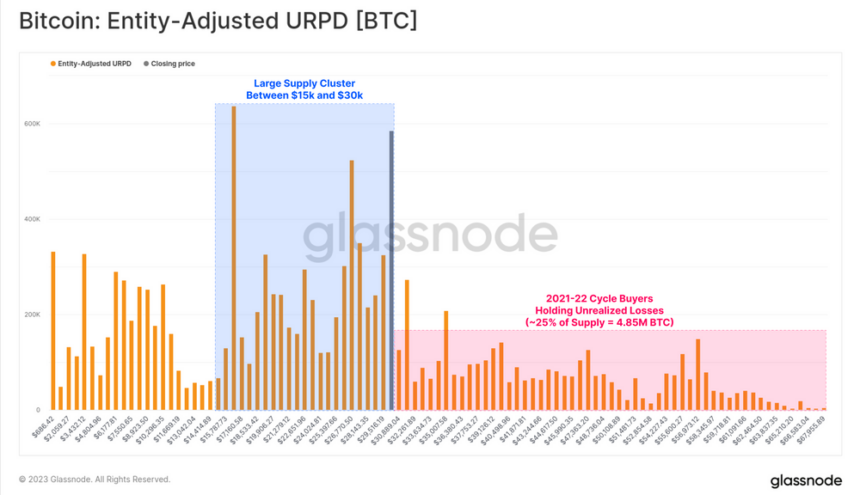Bitcoin Inscriptions Cool Off, Transactions Heat Up: What’s Next For The Market?

Bitcoin (BTC) has been consolidating below the mid-point of the 2021-22 cycle at $30,000, with some on-chain activity metrics cooling off while others, such as money transfer volumes, are picking up. This suggests positive momentum and growing adoption for the asset, according to a recent report from Glassnode.
Bitcoin Metrics Suggest A Wild Ride Ahead
The report highlights that BTC’s recovery in 2023 has been remarkably robust in terms of price performance and network utilization, indicating strong underlying demand for the asset.
Active address momentum is climbing again, indicating a healthy network and growing adoption of Bitcoin. The balance of supply held in profit vs. loss has reached an equilibrium point, synonymous with the several months-long ‘re-accumulation period’ in past cycles.
Moreover, the report suggests that BTC volumes being transferred are starting to pick up meaningfully. BTC changing hands, lifting 75% off the FTX lows, now reaching $4.2 billion per day in total settlement. This is a positive sign for the Bitcoin network, indicating a return toward the dominance of BTC monetary transfers.
The report also provides a chart demonstrating a significant supply cluster between $15,000 and $30,000, indicating that many coins changed hands over the last 12 months.

Conversely, just 25% of the supply was acquired at prices above $30,000, held by buyers from the 2021-22 cycle.
Furthermore, the Long and Short-Term heuristic shows that a sizeable volume of long-term holders (LTH) supply was acquired between $15,000 and $25,000 and remains unspent, despite prices reaching $31,000. Additionally, almost all coins with an acquisition price above $30,000 are held by LTHs, who are likely to create resistance should the market rally higher.
Moreover, the report further highlights that the price range between $20,000 and $30,000 has seen expanding accumulation since February, despite regulatory pressure in the US. This supply distribution is quite ‘bottom-heavy,’ suggesting a relatively firm foundation of investor holdings exists below $30,000.
BTC’s Independence From Altcoins On The Rise
Bitcoin’s correlation with altcoins has declined in the first half of 2023, according to a report by Kaiko, a cryptocurrency market data provider.
The report shows that altcoins have been hit hard by rising regulatory uncertainty in the US, with several exchanges delisting major altcoins over the past few weeks. In contrast, Bitcoin has shown resilience, attracting institutional inflows and benefiting from regulatory clarity around its status as a commodity.
The report highlights that Bitcoin’s correlation with other major cryptocurrencies, such as Ethereum, Litecoin, and Bitcoin Cash, has declined significantly since last year.
The decline in correlation is a sign that Bitcoin is becoming less influenced by the movements of other cryptocurrencies, indicating that it is starting to establish itself as a more independent asset.
XRP saw the strongest decrease in correlation, which is linked to the token’s rising volatility as the outcome of the SEC vs. Ripple lawsuit edges closer. The report indicates that XRP’s volatility has increased significantly in recent months, leading to a sharp decline in its correlation with other cryptocurrencies.
The report suggests that Bitcoin’s resilience in the face of regulatory uncertainty is largely due to its status as a commodity, which has been confirmed by regulatory bodies such as the Commodity and Futures Trading Commission (CFTC).
On BTC’s one-day chart, the largest cryptocurrency in the market is currently trading at $30,500, reflecting a 0.9% increase over the past 24 hours.
Featured image from Unsplash, chart from TradingView.com